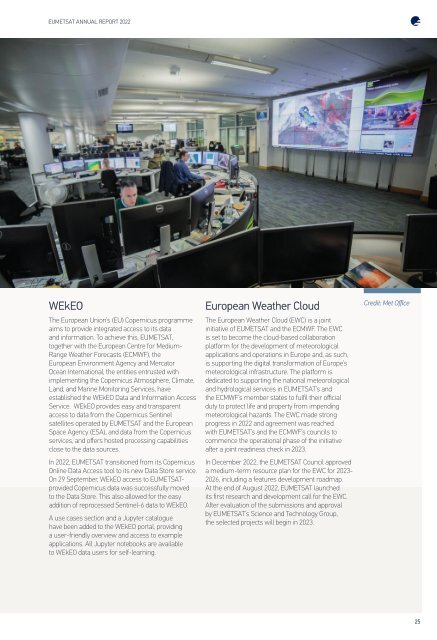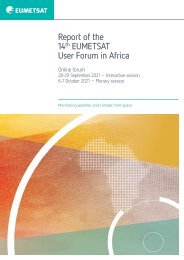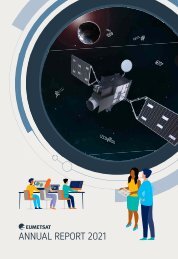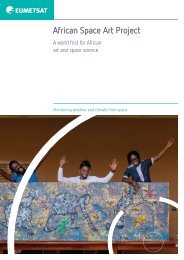EUMETSAT Annual Report 2022
You also want an ePaper? Increase the reach of your titles
YUMPU automatically turns print PDFs into web optimized ePapers that Google loves.
<strong>EUMETSAT</strong> ANNUAL REPORT <strong>2022</strong><br />
WEkEO<br />
The European Union’s (EU) Copernicus programme<br />
aims to provide integrated access to its data<br />
and information. To achieve this, <strong>EUMETSAT</strong>,<br />
together with the European Centre for Medium-<br />
Range Weather Forecasts (ECMWF), the<br />
European Environment Agency and Mercator<br />
Ocean International, the entities entrusted with<br />
implementing the Copernicus Atmosphere, Climate,<br />
Land, and Marine Monitoring Services, have<br />
established the WEkEO Data and Information Access<br />
Service. WEkEO provides easy and transparent<br />
access to data from the Copernicus Sentinel<br />
satellites operated by <strong>EUMETSAT</strong> and the European<br />
Space Agency (ESA), and data from the Copernicus<br />
services, and offers hosted processing capabilities<br />
close to the data sources.<br />
In <strong>2022</strong>, <strong>EUMETSAT</strong> transitioned from its Copernicus<br />
Online Data Access tool to its new Data Store service.<br />
On 29 September, WEkEO access to <strong>EUMETSAT</strong>provided<br />
Copernicus data was successfully moved<br />
to the Data Store. This also allowed for the easy<br />
addition of reprocessed Sentinel-6 data to WEkEO.<br />
A use cases section and a Jupyter catalogue<br />
have been added to the WEkEO portal, providing<br />
a user-friendly overview and access to example<br />
applications. All Jupyter notebooks are available<br />
to WEkEO data users for self-learning.<br />
European Weather Cloud<br />
The European Weather Cloud (EWC) is a joint<br />
initiative of <strong>EUMETSAT</strong> and the ECMWF. The EWC<br />
is set to become the cloud-based collaboration<br />
platform for the development of meteorological<br />
applications and operations in Europe and, as such,<br />
is supporting the digital transformation of Europe’s<br />
meteorological infrastructure. The platform is<br />
dedicated to supporting the national meteorological<br />
and hydrological services in <strong>EUMETSAT</strong>’s and<br />
the ECMWF’s member states to fulfil their official<br />
duty to protect life and property from impending<br />
meteorological hazards. The EWC made strong<br />
progress in <strong>2022</strong> and agreement was reached<br />
with <strong>EUMETSAT</strong>’s and the ECMWF’s councils to<br />
commence the operational phase of the initiative<br />
after a joint readiness check in 2023.<br />
In December <strong>2022</strong>, the <strong>EUMETSAT</strong> Council approved<br />
a medium-term resource plan for the EWC for 2023-<br />
2026, including a features development roadmap.<br />
At the end of August <strong>2022</strong>, <strong>EUMETSAT</strong> launched<br />
its first research and development call for the EWC.<br />
After evaluation of the submissions and approval<br />
by <strong>EUMETSAT</strong>’s Science and Technology Group,<br />
the selected projects will begin in 2023.<br />
Credit: Met Office<br />
25









